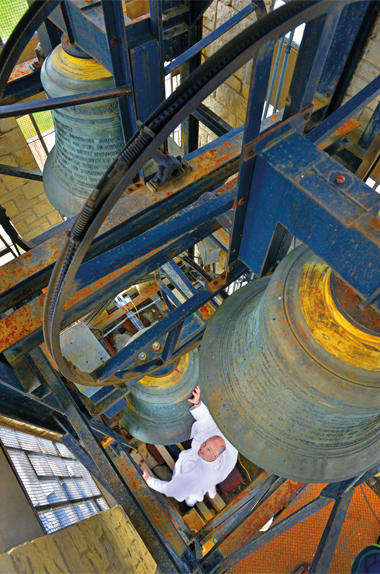Norbertine Now/Hark the Glad Sound!
 Walk near St. Norbert Abbey at the right time and you will hear the sweet peal of bells descending from the tower, filling the air with a prayerful reminder of the abbey’s presence.
Walk near St. Norbert Abbey at the right time and you will hear the sweet peal of bells descending from the tower, filling the air with a prayerful reminder of the abbey’s presence.“The bells alert people that something is happening,” says the Rev. Jim Baraniak, O.Praem., ’88, prior at the abbey.
The abbey’s six bells were cast in Holland at the Bell-Foundry of Petit and Fritsen Ltd. and consecrated by Bishop Stanislaus Vincent Bona of Green Bay on July 2, 1958. The six bells were installed in the church tower immediately following their consecration.
The bells are fully automated and ring on a timer system – or, a switch can be flipped to ring them at special times. On a daily basis, the bells ring at 7:30 a.m., noon and 6 p.m. to announce the daily Angelus prayer times. (The actual morning Angelus is at 6 a.m., but the abbey wanted to be “a good neighbor” so the time was moved back 90 minutes.)
“The Angelus ringing is very distinctive,” Baraniak says. “It’s a sequence of three tolls, followed by three tolls, followed by three tolls and then two peals that ring for about a minute.”
The bells are also rung daily at 4:20 p.m. – 10 minutes before the start of daily Mass at 4:30 p.m.: “It’s a reminder that Mass is about to start so you should get to church.”
The bells are rung for special occasions, too, such as the selection of a new pope and a new abbot, or the death of a Norbertine.
“One bell is struck by a hammer for the number of years old that the Norbertine was at his death, at about 10 seconds apart,” Baraniak says.
“Traditionally, the bells were a way to communicate. People would hear the bells as a reminder that Mass was coming up or, if the bells rang at an odd time, that something important happened.”
Baraniak explains the abbey also rings the bells at the end of Christmas and Easter Masses. “It’s a wonderful sound to have people hear that as they exit the church. It sounds so good.”
The bells are in tune and in sync with each other: “They sound beautiful together.”
Maintenance crews from the abbey and St. Norbert College care for the bells. The bells are on big rollers and chains, and need to be oiled regularly so they work well, Baraniak says. “The bells are used daily and are in great condition. We’re appreciative of the crews who work on them.”
About the bells
Each of the six bells in the St. Norbert Abbey peal is named and carries an inscription, the coat of arms of the person in whose memory the bell is dedicated and the abbey shield. The bells include:
- St. Norbert (G), 1,540 lbs. Named for St. Norbert and in perpetual memory of all the benefactors of the order, but especially the thousands of generous souls throughout the United States whose contributions made the construction of the abbey possible. Inscribed: “May this bell always proclaim the gratitude of the Canons of St. Norbert Abbey.”
- Blessed Mary Virgin (E), 2,640 lbs. Honoring “Mary Immaculate, Patroness of the United States,” the bell is dedicated in perpetual memory of Pope Pius X and his successors in the Chair of Peter. Inscribed: “May its voice always proclaim the glory of God, the liberty of His Church and the freedom of our country.”
- St. Joseph (A), 1,100 lbs. Named for the spouse of the Blessed Virgin Mary and dedicated in memory of the Right Rev. Bernard Henry Pennings, O.Praem., founder and first abbot. Inscribed: “May all who hear this bell be inspired both to fraternal charity and a deep devotion to the patron of the universal church.”
- St. Hubert (C), 640 lbs. Named for St. Hubert and dedicated in memory of the Most. Rev. Hubert Albert Noots, abbot general of the Order of the Canons Regular of Prémontré. Inscribed: “May it serve as a symbol of our gratitude to him and a pledge of our loyalty to those who succeed him.”
- St. Stanislaus (D), 440 lbs. Named for St. Stanislaus, in memory of “our beloved Bishop of the Diocese of Green Bay, His Excellency the Most. Rev. Stanislaus Vincent Bona.” Inscribed: “The dedication of this instrument is a token of our esteem for Bishop Bona and a pledge of our loyalty and devotion to him and his successors.”
- St. Milo (E), 310 lbs. Named for St. Milo in perpetual memory of the Right Rev. Milo Ondersteijn, abbot of “our mother abbey of Berne, and pater abbas of St. Norbert Abbey.” Inscribed: “May this instrument serve as an enduring symbol of the filial love and devotion of Berne’s eldest daughter, St. Norbert Abbey.”
July 1, 2017











